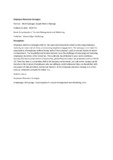| dc.description.abstract | Employee retention strategies refer to the organizational policies aimed at retaining employees, reducing turnover and attrition, and ensuring employee engagement. The main goal is to meet the expectations of employees without losing sight of the company’s goals to ensure maximum return on investment. The hospitality and tourism industry faces the challenge of employing and retaining employees more than other industries. This could also be attributed to poor work conditions, business failures in some sectors of economies, global financial crises and pandemics such as COVID-19. There has been a competitive shift in the business environment, not only in the business world but also in the mindset of employees who are willing to switch whenever they are dissatisfied with any aspect of their job (Bitok, Nzioka and Munyiri, 2019). | en_US |

